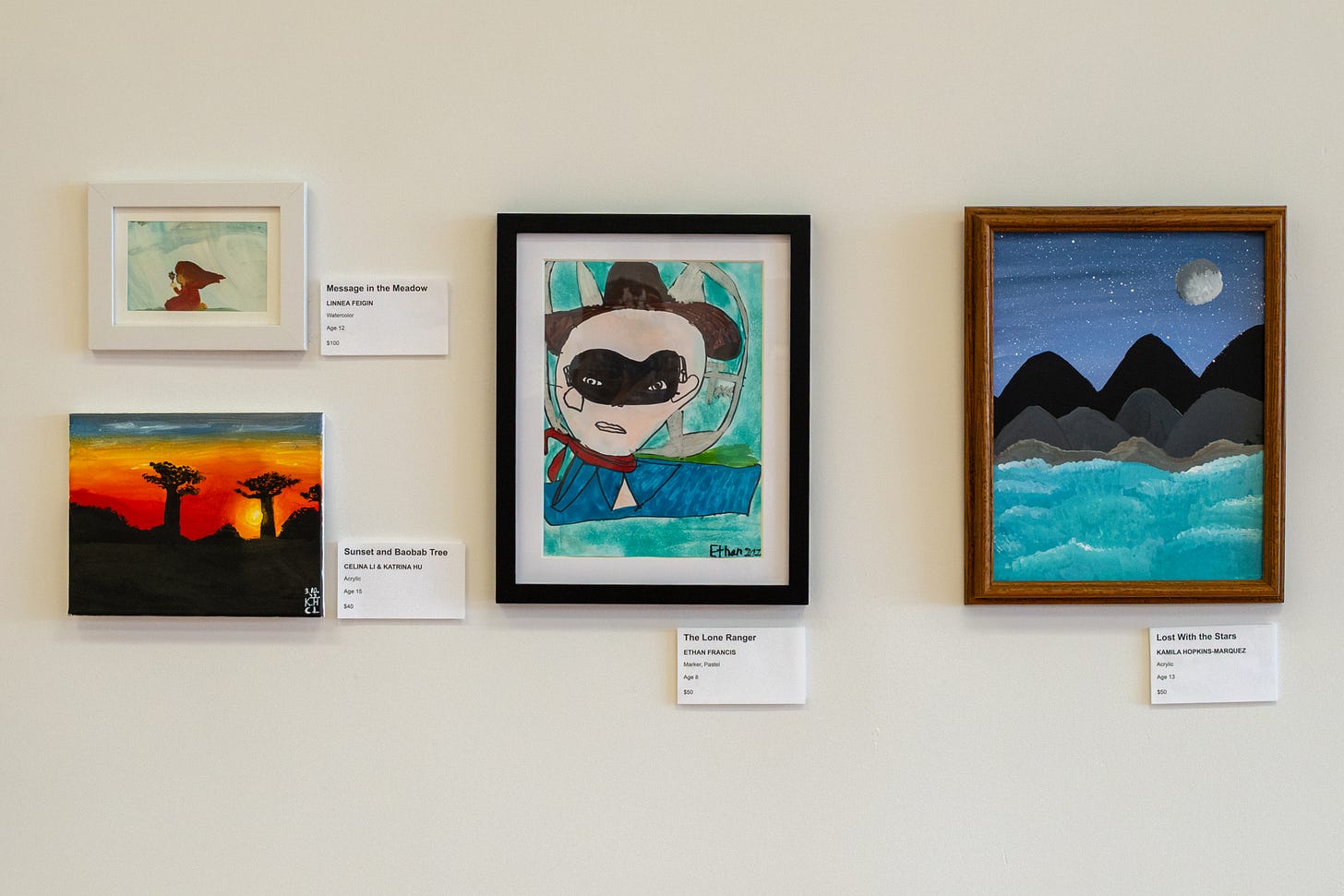Editor’s Note: I’m revisiting some essays I wrote last year, retooling them, tightening the screws, and posting them again. Apologies if you’ve seen this before.
The Lone Ranger has been staring at me for two years. Not the real one, obviously. I’m talking about a drawing of him, done in colored marker by an eight-year-old named Ethan. It hangs above my desk like some kind of low-stakes moral compass. He’s got a mask, a cowboy hat, and a face that suggests he knows I’m ignoring my to-do list.
This wasn’t planned. I didn’t set out to build a collection of artwork by children. But here we are.
The truth is, I have a problem. I get attached to things, objects, moments, and people I’ve never met. I don’t mean in a hoarder way, although my shelves suggest otherwise. I mean, in the way that makes you stare at a kid’s drawing on a gallery wall for two months straight and then feel guilty leaving it behind. It’s not rational. It’s not even about the art most of the time. It’s about the story behind it.
And the problem is, stories find me. Especially the strange ones.
When we hosted our first youth art show at the gallery, it felt like a nice idea. Get some local kids involved, give them a chance to see their work in a real gallery. Harmless, right? I didn’t expect to be emotionally body-checked by the Lone Ranger, drawn by a kid who watches black-and-white Westerns with his grandma. But there he was. Masked. Stoic. Judging my every move while I scrambled to keep the artwork straight. Not metaphorically straight. Literally straight. Ninety degrees. Aligned. Not crooked. The kind of detail that matters to no one until it suddenly matters to everyone.
I stared at that piece more than any other. I even found myself giving it updates. “We sold two more pieces today, Ranger. You proud?” By the end of the show, I couldn’t leave him behind. So I bought it. Paid real money for a drawing by a third grader. No regrets.
Except now I had a new problem.
Ethan came back the next year.
And the work had changed. Gone was the Lone Ranger. In his place was a charcoal drawing of a dark cabin in the woods. No cowboys. No heroic poses. Just a structure barely visible through black smudges and crooked trees. It looked like something out of a Grimm fairy tale. The kind of place you approach slowly, pretending you didn’t hear the floorboards creak.
Naturally, I bought it too.
This time I gave it to a friend, someone who appreciates that kind of eerie mood. It hangs in her house now, the cabin keeping quiet company alongside her shelves of horror novels and weird antiques. I like to think the Lone Ranger and the cabin exist in parallel universes, each holding still, each waiting for something.
Here’s where the real issue comes in. I can’t stop doing this. Not just with Ethan’s work, but with art in general. Especially art with a story. Especially if that story is odd, quiet, or unfinished. I tell myself I’m supporting artists, that I’m building a community, that I’m helping create something meaningful. And I am. But I’m also feeding a part of me that needs to believe objects can hold memory. That a drawing on a wall can be more than decoration.
Sometimes I worry that I’m too sentimental. That I’m one rainy day away from making a documentary about a single thumbtack and calling it “The Pin That Held Us Together.” But other times, I think this is exactly what art is supposed to do. Sneak in. Settle down. Ask for nothing. Change everything.
The solution isn’t to stop buying art. The solution is to keep saying yes to the moments that move me. To trust that something drawn with a Crayola marker by an eight-year-old can carry more meaning than all the framed gallery prints in the world. The solution is to keep giving space, on my walls, in my home, in my life, for things that speak.
I don’t care if that sounds dramatic. I’m 54. I drink whiskey and have opinions about film stocks. I’ve earned the right to get attached to things.
Ethan’s cabin drawing? It helped me see something else, too. That growth isn’t always bright or cheerful. Sometimes it’s quiet. Sometimes it’s made of charcoal and negative space. Sometimes the best thing we can do is give it a wall to lean against and some room to breathe.
I’ve spent most of my adult life working in small towns with people who don’t get a lot of recognition for what they make. Art isn’t always easy to explain in these places. It doesn’t pay the bills. It doesn’t fill potholes. But it builds something else. A sense that what we feel matters. That there’s value in what’s handmade, imperfect, and personal.
That’s why we started the gallery. Not to sell high-end work to collectors, but to remind people that their voices matter. That their scribbles and smudges might stick with someone. That even a masked cowboy drawn during a commercial break can find a home.
I think about Ethan sometimes. I wonder what he’ll draw next. I wonder if he knows the Lone Ranger still watches me work. That his art made someone stop, feel something, and listen. I hope he does.
And if he ever submits to one of our art shows again, I’ll probably buy that one too.



